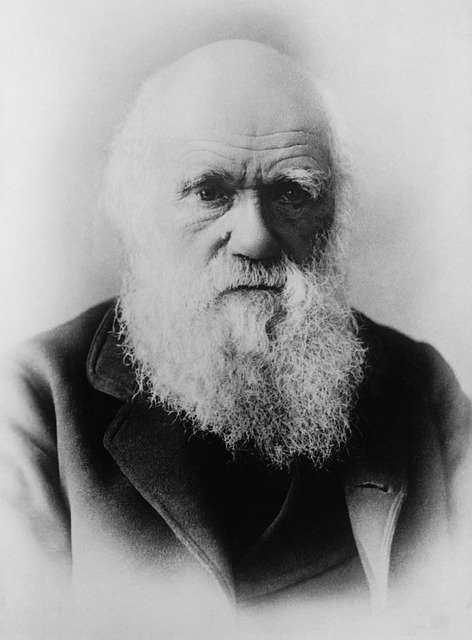By Tim Lambert
His Early Life
Charles Darwin was one of the great scientists of the 19th century. He was born on 12 February 1809 at the Mount House, Shrewsbury. His father was a doctor. His mother died when he was 8 years old. Charles had one brother and four sisters. Up to the age of 8 Charles was taught by an older sister. He then began school. From his earliest years, Charles Darwin was interested in natural history. However, he was a poor scholar.
He went to Edinburgh University to study medicine but left after 2 years. His father decided he should be a clergyman so Charles Darwin then went to Cambridge University.
Charles Darwin left Cambridge University in 1831. The same year he signed up to sail, without pay, as a naturalist on a ship called the Beagle. Its captain was Robert Fitzroy and it sailed on 27 December 1831.
In February 1832 the Beagle reached Brazil. They stayed in Brazil until July 1832 then sailed to Montevideo. Darwin spent three years in different parts of South America collecting specimens. Then in September 1835, the Beagle sailed to the Galapagos Islands.
Charles Darwin was surprised to learn the local people could tell by looking at a tortoise which island it came from. Darwin also studied finches. Each island had a different species of finch. Later Darwin concluded that all were descended from a single species of finch. On each island, the finches diverged and became slightly different.
In December 1835 Charles Darwin visited New Zealand and Tahiti. In January 1836 he reached Australia. The beagle then sailed to Mauritius and South Africa before sailing north into the Atlantic.
Finally, the Beagle arrived at Falmouth on 2 October 1836 and two days later Darwin arrived in Shrewsbury.
Charles Darwin then wrote several books about his voyage. The first was Journal of Researches, an account of his voyage. He also wrote Coral Reefs, published in 1842, Volcanic Islands (1844), and Geographical Observations on South America (1846). Darwin gained a reputation as a brilliant geologist.
Meanwhile, Darwin was influenced by a geologist called Charles Lyell. In 1830 he published a book called Principles of Geology. In it, Lyell proposed a theory called uniformitarianism. He showed that rocks and the landscape were formed over vast periods by very slow processes. However, Lyell did not believe that one species of animal could change into another.
His Theory
Charles Darwin disagreed. By 1836 he believed that species of animals could change. In July 1837 Darwin began to write notes about his theory. He called his notes The Transmutation of Species.
In October 1838 Darwin thought of how one species could change into another. He noticed that individual members of a species vary. Furthermore, all animals are competing with each other to survive. If the environment changed in some way, say if a new, faster predator appeared then any herbivores that could run slightly faster than other members of its species would be more likely to survive and reproduce. Any herbivores that ran slightly slower than most would be more likely to be eaten. Slowly a new, faster herbivore would evolve. This was later called the survival of the fittest.
Meanwhile, on 11 November 1838, Charles Darwin proposed to his cousin Emma Wedgwood. They married on 29 January 1839. As well as getting married Darwin became more famous as a scientist. On 24 January 1839, he was elected a fellow of the Royal Society. Darwin’s first son was born on 27 December 1839. Altogether he had 10 children.
For years Charles Darwin studied nature looking for evidence to support his theory. For much of that time, he suffered from ill health.
Then in 1858 Charles Darwin received a letter from Alfred Russel Wallace. It turned out that Wallace had independently devised a theory of evolution by natural selection.
Therefore Wallace’s work and Darwin’s theory were presented to a scientific society called the Linnaean Society on 1 July 1858. The two men’s work was also published in the society’s journal.
Darwin was now galvanized into publishing his theory. And so his monumental work The Origin of Species was published on 24 November 1859. It proved to be a bestseller. However, Darwin’s book was criticized by some people.
In 1860 T. H. Huxley (a supporter of Darwin) had a public debate with Darwin’s opponent Bishop Wilberforce (known as ‘Soapy Sam’). The bishop was defeated and gradually the theory of evolution was accepted.
Charles Darwin published 10 more books after 1859. Six were about botany, one was about earthworms. Only three were about evolution. One of these was The variation of Animals and Plants under Domestication (1868). He also published The Descent of Man in 1871. In it, he explained his ideas about the evolution of man. In 1872 Darwin published The Expression of the Emotions in Man and Animals.

Darwin’s last book was on earthworms and was published in October 1881 shortly before he died. Charles Darwin died of a heart attack on 19 April 1882. He was 73.